Spicy foods have always been a cultural delicacy across various nations. They challenge our taste buds, introduce us to new flavors, and for some, they become an addictive culinary journey. One such spicy delight that has gained immense popularity worldwide is the Takis rolled corn tortilla chip. It promises a burst of flavor and boasts a commendable heat level, measured in Scoville units. This article will delve into the Scoville scale, the spiciness of Takis, and its different variants.
How Many Scoville Units are Takis?
Takis rolled corn tortilla chips have 8000-9000 Scoville units. They offer a spicy, salty, and intense flavor. Distributed by Barcel, a Mexican snack food maker, Takis Fuego, Nitro, Blue Heat, and Crunchy Fajitas are available varieties.
Understanding the Scoville Heat Scale
Before examining Takis’s exact spiciness, it’s essential to understand the Scoville scale. Named after its creator, Wilbur Scoville, in 1912, this scale measures the spiciness or heat of chili peppers and spicy foods. It is based on the concentration of capsaicin, the chemical responsible for the spicy sensation.
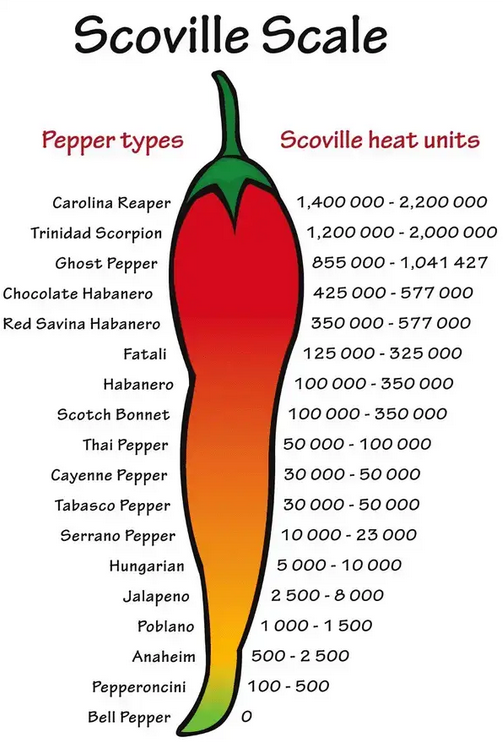
To put things into perspective, bell peppers have no heat and are rated at 0 Scoville Heat Units (SHUs). In contrast, the notorious Carolina Reaper, one of the world’s spiciest chili peppers, has over 1.5 million SHUs.
How hot are Takis on the Scoville scale?
Blue Heat Takis is hot, with around 9000 Scoville Units, while Takis Fuego and Takis Nitro have around 8500 Scoville Units. Takis is one of the spiciest foods you can buy in the supermarket.
Blue Heat Takis are known for their distinctive bold blue hue and equally bold heat, ranking at 9,000 Scoville Units. This heat measurement indicates a higher concentration of the spicy compounds, giving them a more intense kick when compared to some other snacks on the market.
On the other hand, while still delivering a formidable punch, Takis Fuego and Takis Nitro are slightly milder in comparison, clocking in at around 8,500 Scoville Units each. Takis Fuego is characterized by its unique chili pepper and lime blend, offering a compelling mix of spiciness and tanginess. Meanwhile, with its habanero and lime flavoring, Takis Nitro delivers a robust spiciness paired with a refreshing citrus twist.
Despite these subtle variations in spiciness among the different flavors, Takis undeniably leans heavily into the spicy snack niche as a brand. In the context of readily available snacks in most supermarkets, Takis stands out as one of the most intense options. Takis is a top contender for individuals seeking a spicy challenge or simply looking to elevate their snacking experience with a burst of heat.
Takis and its Scoville Rating
Takis rolled corn tortilla chips are between 8000 and 9000 on the Scoville scale. For many, this is considered a moderate heat level. They’re spicy enough to give that desired kick but not overwhelmingly hot for the average person. This heat level can be compared to a fresh jalapeño pepper, which ranges between 2,500 and 8,000 SHUs.
But what makes Takis stand out is not just its heat. The spicy, salty, and intense blend makes it a favorite among snack enthusiasts. The acidity of the chips also adds to the tangy sensation, creating a multifaceted taste experience.
The Company Behind Takis: Barcel
Barcel, a renowned Mexican snack-food manufacturer, is the genius behind Takis. The company has a rich history in the snack industry and has consistently introduced innovative products that cater to changing consumer preferences. Takis is one of their most successful products, especially among younger audiences.
With its unique rolled shape, vibrant packaging, and catchy marketing campaigns, Takis has secured its spot in the global snack market. But the brand’s success isn’t limited to its original flavor. Barcel, understanding the diverse palate of its consumers, has introduced various Takis flavors.
Exploring the Takis Varieties
- Takis Fuego: This is arguably the most popular variant and can be identified by its distinct purple packaging. “Fuego” translates to “fire” in English, and these chips live up to their name. They have a hot chili pepper and lime flavor, offering a mix of spiciness and tanginess.
- Takis Nitro: Packed in a black and green bag, Takis Nitro offers a unique flavor blend of habanero and lime. It is slightly less spicy than the Fuego but still packs a punch.
- Takis Blue Heat: These chips, a relatively new addition to the Takis family, have a vibrant blue hue. They promise an intense heat level, making them a favorite for those seeking an extra kick.
- Takis Crunchy Fajitas: These chips are a flavorful twist on the classic fajita taste. While they offer a milder heat compared to the Fuego and Nitro variants, they don’t compromise on flavor. The taste is reminiscent of grilled meats and sautéed vegetables, typical of a fajita.
How Many Scoville Units is Takis Fuego?
Takis Fuego is a spicy snack variant known for its fiery kick, which ranks around 8500 Scoville units. This heat level is attributed to the chili and lime flavoring, which provides a blend of spiciness and tanginess popular among spicy food enthusiasts.
Takis Fuego is one of the most popular variants of the Takis brand. It is recognized for its purple packaging and fiery taste. The word “Fuego” translates to “fire” in English, a fitting name given the flavor’s intensity.
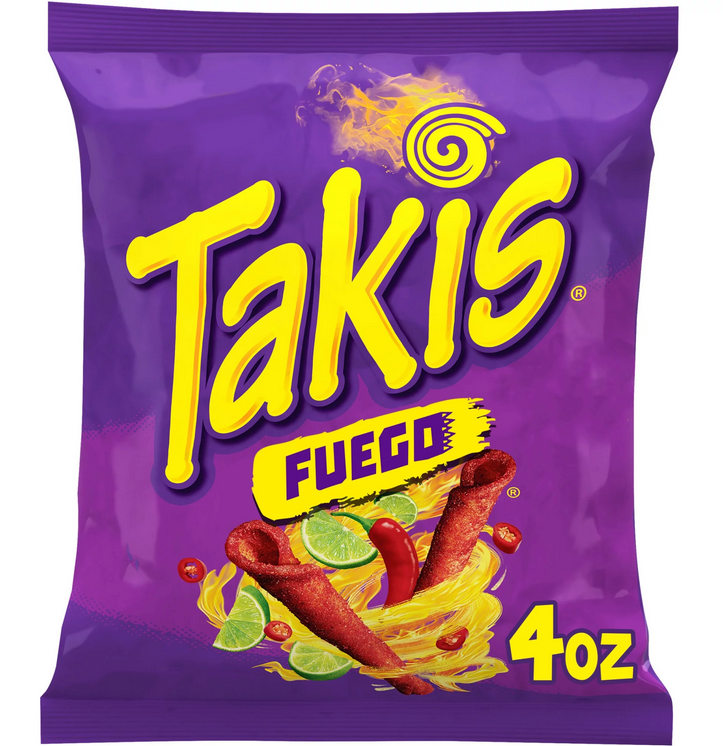
Here’s a detailed breakdown of its taste:
1. Spiciness: Its prominent spiciness is at the forefront of the taste experience with Takis Fuego. The heat is immediate, sharp, and lingers after consumption. It’s not the type of spiciness that’s overpowering or unbearable for most; it’s a pleasant warmth that spreads across the palate and can cause a tingling sensation.
2. Tanginess: Complementing the spiciness is a distinctive tanginess from the lime flavoring. This tangy note adds an acidic brightness to the chips. When you first bite into a Takis Fuego, the lime’s citrusy zest hits you, creating a vibrant contrast to the chili’s heat. This spicy and tangy combination sets Fuego apart from many other spicy snacks.
3. Saltiness: Integral to the Takis Fuego experience is its saltiness. The salt enhances the other flavors, making the spiciness more pronounced and the tanginess more refreshing. It adds a savory dimension to the chips, making them incredibly moreish.
4. Crunchiness: While not directly related to taste, Takis Fuego’s crunchiness contributes to its overall flavor experience. The rolled corn tortilla chips have a firm, crispy texture that’s satisfying to bite into. This crunchiness also influences how the flavors are released, with the spices, lime, and salt blending seamlessly as you chew.
5. Slight Smokiness: A subtle smokiness underlying the primary flavors of spice, tang, and salt. This smoky undertone gives Takis Fuego a depth that makes the flavor profile richer and more complex. It reminds one of roasted or grilled chilies, adding another layer to the taste journey.
How Many Scoville Units is Takis Nitro?
Takis Nitro has 8200 Scoville Units and is flavored with habanero and lime, delivering a robust spiciness. While the exact Scoville rating can vary, it’s comparable to other Takis varieties. Takis Nitro’s unique blend provides a fiery punch and refreshing citrus tang.
With its recognizable black and green packaging, Takis Nitro is a unique flavor variant within the Takis lineup. The name “Nitro” suggests intense flavor and energy; this snack does not disappoint.
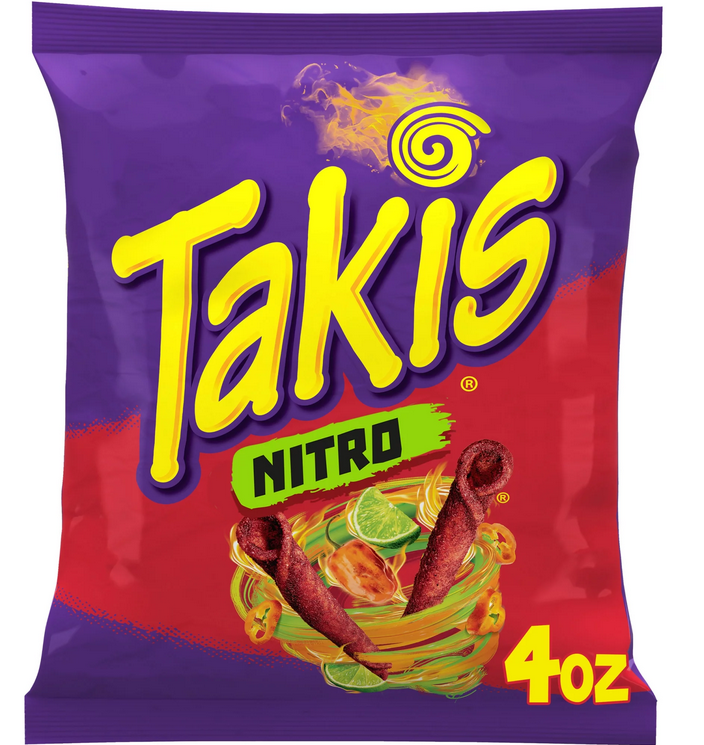
Here’s a thorough examination of its distinct taste:
1. Spiciness: Takis Nitro is infused with the unmistakable heat of habanero peppers. Habanero, known for its fiery kick, imparts the chip a warm, vibrant spiciness. The heat is evident but not overpowering, offering a deep and somewhat fruity spice characteristic of the habanero pepper. It provides an exhilarating sensation that awakens the senses without pushing them to the extreme.
2. Tanginess: Like its cousin, Takis Fuego, Nitro has a tangy undertone, thanks to the addition of lime flavoring. This citrusy note cuts through the habanero’s heat, providing a refreshing counterbalance. The lime’s zesty touch creates a lively and bright contrast, ensuring the spiciness does not become monotonous.
3. Saltiness: Salt, as with most savory snacks, plays a pivotal role in amplifying the flavors of Takis Nitro. It enhances the fiery punch of the habanero and accentuates the lime’s acidity, binding these contrasting flavors into a cohesive taste experience. This salinity engages the taste buds and entices you to reach for more.
4. Crunchiness: The texture, while not a flavor, profoundly influences the overall tasting experience of Takis Nitro. These rolled corn tortilla chips are delightfully crunchy, providing a satisfying tactile sensation with every bite. The crispness ensures a full release of flavors, letting the spiciness, tanginess, and saltiness meld seamlessly in the mouth.
5. Earthiness: An underlying earthiness, possibly from the corn tortilla and the natural taste profile of habanero peppers, gives Takis Nitro a grounded flavor foundation. This earthy touch lends depth and richness to the snack, adding a subtle complexity beneath its more vibrant notes.
How Many Scoville Units is Takis Blue Heat?
Takis Blue Heat, known for its vibrant blue hue and intense flavor, has around 9000 Scoville Units. A tangy undertone balances its fiery kick for a thrilling taste experience.
With a color as vibrant as its name, Takis Blue Heat is one of the more visually striking members of the Takis family, easily identifiable by its bold blue hue. But beyond its eye-catching appearance, the taste of Blue Heat promises an adventure for the palate.
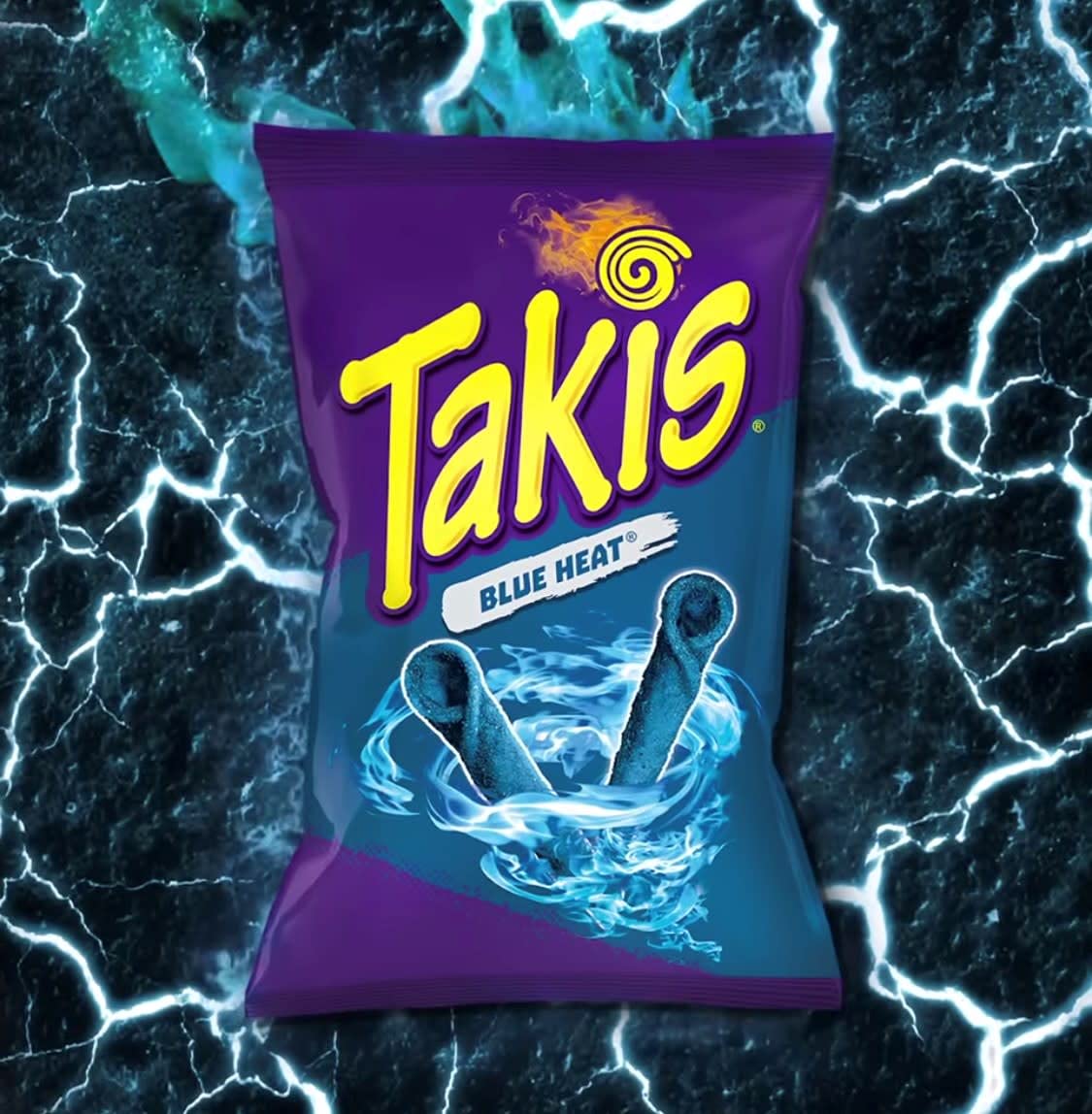
Here’s an in-depth look at its distinctive flavors:
1. Intense Spiciness: As its name implies, “Blue Heat” boasts an elevated spice level. This variety is intended for those chasing that extra kick, offering a spice level a notch above some other Takis flavors. The heat is immediate, sharp, and lasts, giving the sensation of a fiery wave that persists on the palate.
2. Tanginess: In line with the Takis tradition, Blue Heat is not just about spice; a tangy edge provides a refreshing contrast. The citrusy notes help balance the intensity of the spiciness, ensuring that the flavor profile remains multidimensional. This marriage of fiery heat and zesty tang keeps the snack engaging from the first chip to the last.
3. Saltiness: The saltiness in Blue Heat is present, subtly elevating the chip’s other dominant flavors. Salt acts as a flavor enhancer, making the spicy and tangy notes more pronounced and binding them to a harmonious taste experience. It adds depth and rounds out the profile, preventing flavor from overshadowing the others.
4. Crunchiness: Takis Blue Heat, like its counterparts, offers a delightful crunch with its rolled corn tortilla form. This crispy texture adds to the sensory pleasure of eating the snack and influences how the flavors are perceived. The crunch releases the spices, salt, and tang in a burst, creating a layered tasting experience.
5. Slight Bitterness: An intriguing aspect of Blue Heat’s flavor profile is its subtle hint of bitterness. This could be attributed to the blue coloring or any ingredient used to achieve its vivid hue. The faint, bitter undertone adds complexity to the snack, making it even more captivating for those with a discerning palate.
How Many Scoville Units are Takis Crunchy Fajitas?
Takis Crunchy Fajitas has around 8500 Scoville units that offer a savory twist inspired by the classic fajita dish. It’s estimated they’re around 8,400 to 8,600 Scoville units, providing a subtle spicy kick amidst their rich flavors.
Takis Crunchy Fajitas, distinguishable from its fiery siblings, presents a taste inspired by the classic and beloved fajita dish. This variant offers a more toned-down heat but compensates with a richer, more savory flavor reminiscent of grilled feasts.
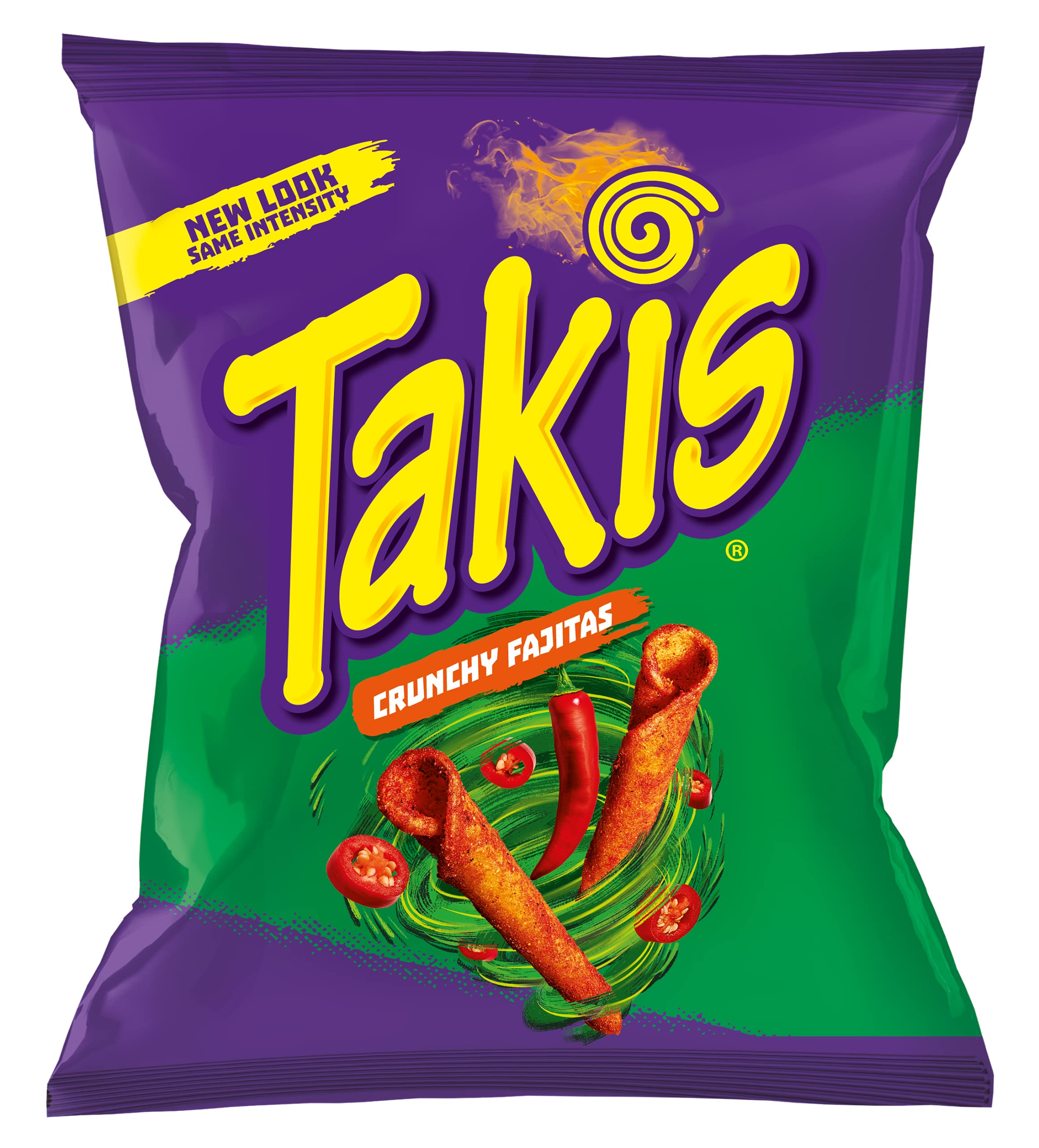
Let’s delve deeper into the unique flavor symphony of Crunchy Fajitas:
1. Savory Grilled Notes: The primary taste sensation of Crunchy Fajitas is its unmistakably savory grilled flavor. This immediately evokes images of sizzling fajitas on a hot grill. The taste is reminiscent of seared meats, charred vegetables, and the smoky aroma that arises when cooked to perfection.
2. Mild Spiciness: While Crunchy Fajitas is milder in heat than other Takis variants, it still offers a hint of spiciness. This mild warmth complements the savory grilled notes, adding depth and character to the flavor. It’s a gentle heat that tingles the taste buds without overpowering them.
3. Tangy Undertones: True to the fajita inspiration, Crunchy Fajitas features a tangy undertone that can remind one of the lime or citrus squeeze that often accompanies a fajita dish. This subtle tanginess adds freshness to the mix, cutting through the savory notes and providing a balanced contrast.
4. Earthy Vegetal Hints: Crunchy fajitas have a faint vegetal note, echoing the bell peppers and onions typically found in traditional fajitas. This earthy touch offers a nuanced complexity, grounding the flavor profile and enhancing the grilled and tangy elements.
5. Saltiness: The saltiness in Crunchy Fajitas is well-balanced, highlighting the snack’s other flavors. It accentuates the grilled notes, amplifies the mild spiciness, and harmonizes the tangy and earthy undertones. The result is a cohesive and multidimensional taste experience.
6. Signature Crunch: Like its Takis siblings, Crunchy Fajitas boasts that characteristic crunch courtesy of its rolled corn tortilla form. This texture plays a significant role in the overall taste journey, releasing myriad flavors in bursts and offering a satisfying mouthfeel.
Conclusion
Takis has managed to carve a niche in the vast world of snacks. Its unique combination of spiciness, saltiness, and tanginess offers a flavor profile that’s hard to resist. Between 8000 and 9000 SHUs, Takis provides an enticing heat level for beginners and spicy food veterans.
The variety of flavors ensures a Takis for everyone, whether you prefer the intense heat of the Blue Heat or the savory notes of the Crunchy Fajitas. If you haven’t tried this spicy sensation, it might be time to challenge your taste buds and see where you stand on the Takis heat spectrum.
- How Many Tablespoons is One Clove of Garlic? - June 26, 2024
- How to Measure 3/4 Cup When You Don’t Have the Right Measuring Cup? - June 6, 2024
- How Much Does Cooked Pasta Weight Compare To Dry? - April 30, 2024
